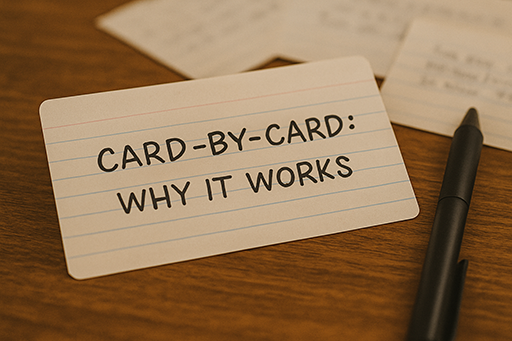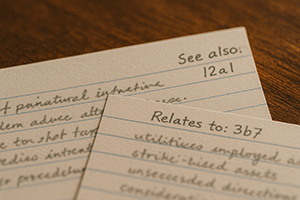Card-by-Card: Why It Works

We’re used to thinking in systems. We want elegant workflows, clever apps, perfect templates. But when it comes to real thinking—the kind that sticks and evolves—complexity can get in the way.
The slip-box method cuts through that noise. It doesn’t ask for a five-year plan or a neatly color-coded database.
It just asks for this:
✍️ One card.
🧠 One idea.
🔗 One connection.
And that’s where the magic begins.
🗂️ The Strength of the Card
Each 3x5 card is small by design. It’s a constraint that forces clarity. You don’t have room for fluff or rambling summaries. Instead, you’re left with just the core idea—what matters most.
This limitation becomes a gift:
- It encourages atomic thinking—one idea per card[1]
- It invites intentional writing, not mindless copying
- It creates a natural filter for what’s worth keeping
When you work card-by-card, your thoughts become sharper. You stop hoarding information and start digesting it.
“Writing is not the capturing of ideas—it’s the processing of them.”

🔗 The Power of Linking
This isn’t about organizing notes into categories. It’s about following the flow of your thoughts.
With each new card, you can connect it to a previous one—“See also: 12a1” or “Relates to: 3b7”—and suddenly, your box starts to develop a memory of its own.
These links are like neurons firing, forming associations that you didn’t even plan.
- You’re not creating a filing cabinet. You’re building a thinking partner
- Ideas grow in unexpected directions, just like in real conversations
- You stop thinking in silos and start thinking in networks
This is what makes a Zettelkasten more than just a pile of notes—it becomes a living system that evolves as you do[2].

🧠 Slow Thinking, Fast Insight
Here’s the part that surprises most people: at first, it feels like nothing’s happening.
You write one card. Then another. Then maybe a third. It’s slow. Quiet. Almost too simple.
But one day, you flip through your box and realize:
You’ve been thinking all along.
Connections emerge. Patterns reveal themselves. And suddenly, what felt like a pile of fragments becomes the outline of an article, a paper, a plan.
This is the real beauty of the slip-box:
You don’t need to force brilliance. You just need to show up consistently—and trust the method.

💡 Final Thought
The world tells us to move fast and store everything.
But maybe that’s the wrong approach for deep thinking. Maybe clarity comes from moving slowly, deliberately—card by card.
The slip-box method works not because it’s high-tech, but because it’s human-sized.
It honors the way we actually think: one idea at a time, with room to breathe.
So next time you have a thought worth keeping, skip the app. Grab a card.
And start the conversation.
- This principle—atomicity—is central to the original Zettelkasten method pioneered by sociologist Niklas Luhmann. See: Zettelkasten.de - The Collector’s Fallacy ↩︎
- For a deeper dive into how note-linking mimics neural architecture, see Andy Matuschak’s working notes on Evergreen Notes ↩︎
